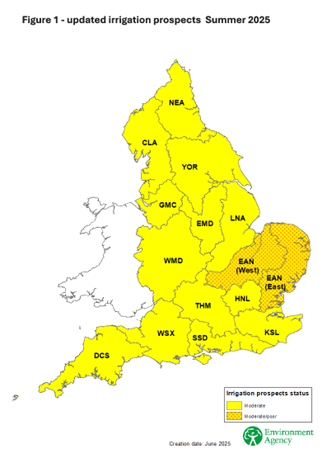
Updated prospects for irrigation – forecasts for Summer 2025
Summary
"Our updated prospects for irrigation across England for the Summer 2025 season is Moderate. The continued dry spring and start to the summer has contributed to a further downgrade to the irrigation prospects since our last report in April.
For the remainder of the irrigation season, we encourage all irrigators to actively review their water needs and consider the range of options to help secure and increase water resilience for the summer."
EA contact details:
- Customer Service Line - 03708 506 506
- Incident Hot Line - 0800 80 70 60
- Flood Line - 03459 88 11 88

Options to support irrigators this summer and beyond:
Contact the Environment Agency as soon as possible if you do not think you’ll be able to comply with the conditions of your abstraction licence.
Review abstraction licences to ensure that they still meet their needs to comply with conditions and meet future requirements.
Continue to follow good irrigation practice such as prioritising night-time irrigation, reducing leaks and avoiding windy conditions.
Engage and communicate with customers to give them early information on quality/yield implications.
Take advantage of significant rainfall events when flows/levels rise above hands off levels allowing a return to abstraction.
Sign up to managing your water abstraction or impoundment licence online. This will allow you to submit abstraction returns and view your licence information. Some licence holders will also have access to water abstraction alerts by email ‘e-alerts
Review cropping, crop varieties and rotation plans for next year taking account of possible limited water availability using tools such as D- Risk to rapidly understand local drought and abstraction risks and thereby support robust decisions.
Short term options are available to improve your access to water outside of your licence conditions. Further information can be found in the Environment Agency guidance water abstraction during prolonged dry weather and drought. The Environment Agency will talk to you about short-term options for improving your access to water outside the conditions of your licence.
There is an Environment Agency Regulatory Position Statement available that covers information on when you can abstract water outside of the conditions of your abstraction licence during a flood warning
Consider trading water with other licence holders to improve access to water supplies. Further guidance can be found on gov.uk which includes a link to Help for Water Rights Trading Data and further link to a water rights trading map
Review plans for longer term investment such as reservoirs for future resilience and securing additional backup storage for livestock where farms are on mains water or boreholes. Farmers should take advantage of future funding rounds from the RPA to help fund this investment
Consider applying for a Local Resource Option screening study with growers in your area to increase longer-term water supply resilience. A new round of applications is now open and more information can be found at How to apply for a local water resources options screening study- GOV.UK
Water resources situation
The irrigation prospects reflect the water situation using current river flows, groundwater conditions, latest available weather forecasts and Met Office seasonal outlooks.
Spring 2025 across England was the driest since 1893. Between the period March to May, England overall received 44% of the long-term average rainfall (LTA) with all areas receiving below average rainfall during the spring period. Southeast England was the driest area only receiving 34% of LTA rainfall during March to May. The start of June has seen a more unsettled spell, bringing some welcome rainfall to farmers and growers which has slowed demands for irrigation, but it has not been enough to reverse the overall impacts from the dry spring. Up to the 17 June England has overall received 63% of LTA rainfall.
The dry spring has seen exceptionally low river flows experienced across northern and central England. Recent rainfall at the start of June had helped increase river flows briefly but these have quickly receded with over half of monitoring sites were classed as below normal or lower for the time of year.
At the end of May, groundwater decreased at most monitoring sites as aquifers continued their seasonal recessions. Almost half of all monitoring sites were classed as normal for the time of year and one site in the Cotswolds is exceptionally low for the time of year.
Soil moisture deficits have started to fall in response to recent rainfall in the north-west but remain very high, soils are much drier than expected across most of England.
The dry spring has seen a greater than normal level of demand on farm irrigation reservoirs especially where there have been hands off flow conditions impacting on surface water abstractions, due to low river flows. Overall, irrigation reservoir stocks are depleted compared to the expected position for the time of year but there is significant variability depending on local conditions.
With an early start to the irrigation season this year and should there be a continuation of the dry conditions during rest of the summer, there is a risk to some irrigation water supplies, particularly where reservoir stocks have been substantially depleted over the spring.
Mark Betson, the NFU’s Water Resources Specialist commented:
“The extreme dry spring this year has notably impacted nutrient uptake in crops, particularly Spring crops (AHDB Crop Development Report). For those crops that are irrigated, some growers have been impacted by hands-off-flow conditions, but these have been relatively few and rains at the end of May reduced the number of these. Irrigators supported by reservoir storage have seen rapid drawdown of stocks. As we move into summer there is no clear signal about wet or dry weather, but even with ‘normal’ conditions there will only be patchy recharge for some areas. There is a range of advice and links to support impacted farmers and growers on our NFU dry weather page”
More information on the current water situation is available at Water situation reports for England - GOV.UK
Long range weather forecast
For the remainder of June, the current very warm or hot conditions are expected to ease with more unsettled conditions moving in from the west. At the start of July, more unsettled conditions are likely across the north and west, with a more broadly settled pattern across the south and east, although some rain may spread across from the north or west at times. Temperatures are expected to be near to or above normal.
More information on weather forecasts is available at the Met Office
Prospects for individual areas
| Area | Prospects for Summer 2025 irrigation season |
| Environment Agency Cumbria and Lancashire | Moderate |
| Environment Agency Devon, Cornwall and the Isles of Scilly | Moderate |
| Environment Agency East Anglia East (covering Essex Norfolk and Suffolk) | Moderate / locally poor in heavily pressured catchments |
| Environment Agency East Anglia West (covering Cambridgeshire and Bedfordshire) | Moderate but poor in Middle Level Fenland and South level Fenland systems. |
| Environment Agency East Midlands | Moderate |
| Environment Agency Greater Manchester, Merseyside and Cheshire | Moderate |
| Environment Agency Hertfordshire and North London | Moderate |
| Environment Agency Kent, South London and East Sussex | Moderate |
| Environment Agency Lincolnshire and Northamptonshire | Moderate |
| Environment Agency North East | Moderate |
| Environment Agency Solent and South Downs | Moderate |
| Environment Agency Thames | Moderate |
| Environment Agency Wessex | Moderate |
| Environment Agency West Midlands | Moderate |
| Environment Agency Yorkshire | Moderate |
Definitions
Prospects for spray irrigation are defined as ‘Good’, ‘Moderate’ or ‘Poor’.
| Good | Water levels are average or above average and supplies are expected to be safe. There is a possibility of minor local controls on abstraction from surface water in late summer if the weather is exceptionally hot and dry. |
| Moderate | Water levels are low. Some controls on surface water abstraction are possible by midsummer if the weather is hot and dry. Controls on abstraction from groundwater are possible in small, sensitive groundwater areas. |
| Poor | Water levels are well below average. Soil moisture deficit is developing early and significant restrictions on abstraction from surface and groundwater are probable. |